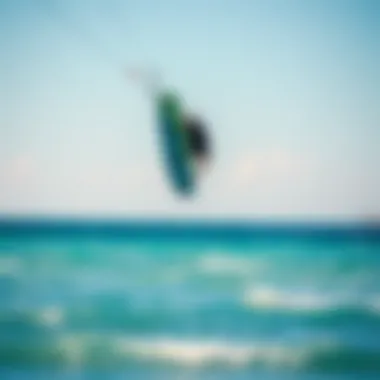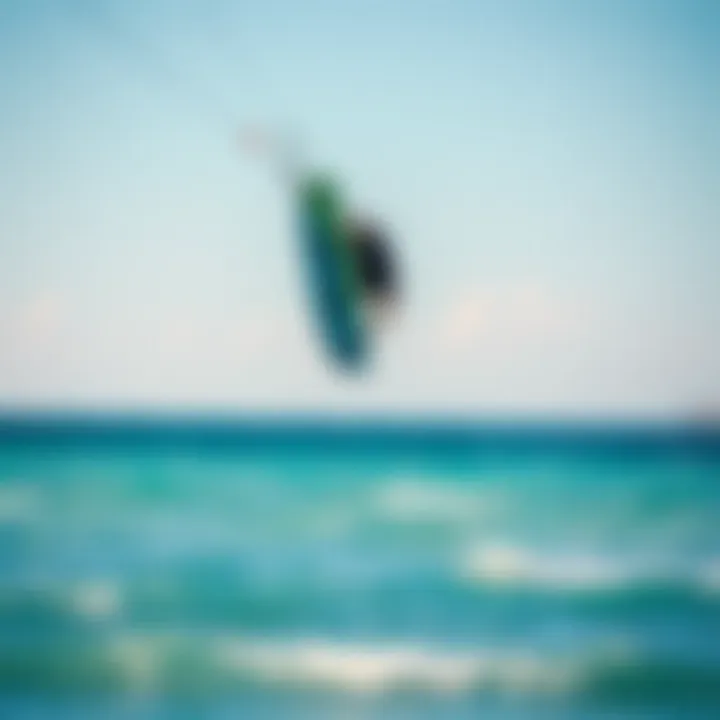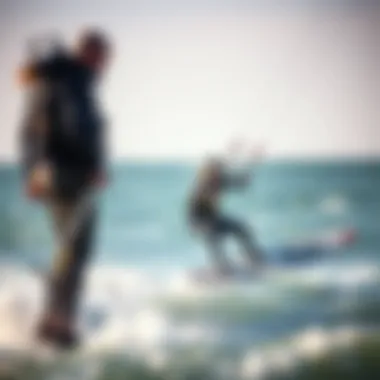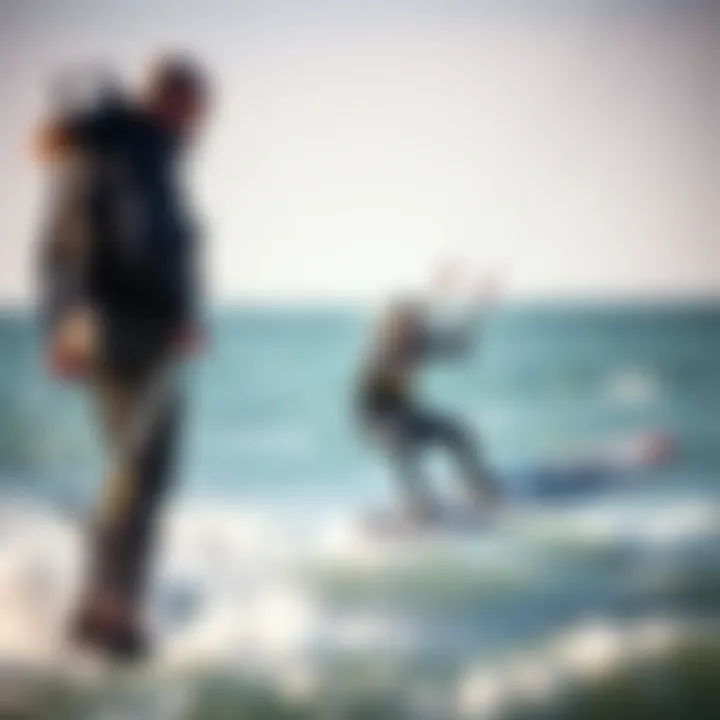Air Foil Surfing: Exploring New Techniques in Kiteboarding


Intro
In the burgeoning world of water sports, air foil surfing has emerged as a game-changer for kiteboarders, adding a new layer of excitement and dynamics to the sport. This innovative technique not only enhances performance but also opens up new possibilities for those looking to explore the ocean's surface in a way that goes beyond traditional surfing. The mechanics involved in air foiling harness the lift generated by hydrofoils, allowing riders to glide above the water with minimal resistance.
While many enthusiasts may have ventured into kiteboarding with standard boards, those willing to embrace air foiling are likely to discover a host of advantages. These range from increased speed and maneuverability to the thrill of riding at heights that were once considered unattainable. However, it's crucial to understand the intricacies of the equipment, the techniques needed to master air foiling, and the safety measures that ensure not just fun, but also protection for riders and the environment.
This article aims to equip both novice and seasoned kiteboarders with the knowledge to elevate their air foil surfing experience. From cutting-edge gear to essential tips for maximizing performance on the water, everything you need to dive into this exciting sport is covered. Let's embark on this journey to explore the depths of air foil surfing and redefine your kiteboarding adventure.
Gear Insights
When it comes to air foiling, the right gear plays a pivotal role in performance and safety. Understanding the equipment landscape can feel overwhelming, especially with the rapid innovation each season brings. Whether you're a seasoned kiteboarder or just starting out, having a grasp of essential gear can make all the difference in your experience.
Latest Gear Reviews
In recent years, several brands have showcased their advancements in kiteboarding gear, each aiming to elevate the air foil surfing experience. Some notable products have made waves in the community:
- Duotone has been leading the charge with its innovative foil designs, particularly the Slick and the Spirit range. These models offer lightweight materials while maintaining durability, perfect for carving through the water with ease.
- Naish has also rolled out their Jet Series, emphasizing early lift and stability. Many riders rave about the way these foils handle in choppy conditions, making them a favorite among advanced surfers.
- Slingshot has introduced its Asylum model, which is highly regarded for its versatility and responsive control, allowing riders to push their limits and experiment with new tricks.
Each of these products comes with unique features tailored for specific riding styles. It’s important to thoroughly evaluate what aligns best with your preferences and skill level before making a purchase.
Essential Gear for Beginners
For those new to air foil surfing, stepping into the sport can be somewhat daunting, especially when faced with an array of options. Here are a few key pieces of gear that every beginner should consider:
- Foil Board: A shorter and wider board designed specifically for foiling, which offers stability and easier maneuverability for novices.
- Kite: Look for something with a good aspect ratio that suits varying wind conditions. A mid-size kite is often a good choice for beginners.
- Foil Setup: Opt for a beginner-friendly foil that provides ample lift and sensitivity to water conditions without being overly challenging to control.
- Safety Gear: Never underestimate the importance of a quality impact vest and helmet, especially when learning new techniques.
By investing in the right gear, newcomers can build confidence and accelerate their learning curve, ensuring a more enjoyable experience on the water.
"Choosing the right equipment is not about the latest trends, it's about what allows you to express your unique style and maximize your enjoyment on the water."
Understanding the gear and how it fits your personal style can be a game changer. In the upcoming sections, we'll dive into advanced techniques and the safety practices every kiteboarder should embrace. Keep reading to unlock more knowledge that can enhance your air foil surfing journey.
Prologue to Air Foil Surfing
Air foil surfing has emerged as a transformative element in the world of kiteboarding, melding creativity with engineering to redefine water sports. Understanding this new wave of kiteboarding is essential for both novices and seasoned riders alike, as it opens up a vast array of possibilities on the water. The art of air foiling involves utilizing specialized boards and wings to lift above the surface, transforming the dynamics of a kite surfer's experience.
Learning about air foil surfing offers vital insights into the underlying technology that is reshaping the sport. It empowers practitioners to achieve new heights, quite literally, enhancing their speed and control while riding the winds and waves. Furthermore, as the popularity of air foiling grows, so too do the benefits associated with it. Riders can glide effortlessly across flat water, dance in the air with ease, and navigate in conditions that once imposed limitations previously thought insurmountable.
The rich context surrounding this sport combines elements from various disciplines of board sports, making it not only an exciting trend but also a complex fusion of biology, physics, and environmental awareness. As such, this article aims to clarify the mechanics and techniques involved in air foiling, as well as to highlight necessary safety considerations and environmental impacts.
By delving deeper into this electrifying segment of kiteboarding, readers will gain a well-rounded perspective on both the thrill and responsibility that comes with navigating this uncharted territory.
The essence of air foiling lies not just in the rush of gliding effortlessly over water, but in mastering a craft that challenges and enhances one's skills in kiteboarding.
Definition and Context
Air foil surfing, at its core, is the practice of using a hydrofoil—a structure that extends below the waterline, allowing a rider to lift above the surface. When a kiteboarder's foil interacts with the water, it generates lift through a shape similar to an airplane wing, which results in the board rising above the water's surface.
In terms of context, this technique caters to a diverse range of conditions. Air foilers operate in light winds where traditional boards might struggle, showcasing a balance between how equipment works and environmental interactions. Each ride becomes a delicate dance between wind patterns, water currents, and rider skill, showcasing a style that is as much art as it is athleticism.
Historical Development in Kiteboarding
The progression of air foil surfing can be traced back to the early days of kiteboarding. Traditional kiteboards primarily relied on wide surfaces to create resistance against the water, which limited speed and agility. Early innovators recognized the potential for foils in board sports through experimenting with paragliders and sailboats.
Notably, the first hydrofoil specifically designed for kiteboarding dates back to the early 2000s, but it wasn’t until the late 2010s that technology saw significant advancements. Manufacturers like Naish and Slingshot began crafting dedicated air foils that could endure the rigors of riding, leading to a surge in interest within the kiteboarding community.
Today, air foil surfing stands at the intersection of tradition and modernity, with rapid innovations continually improving performance. As more enthusiasts take to the waves using foils, this segment has spurred conversations surrounding equipment design, environmental impact, and the very essence of what it means to ride a board. Riding on the trailing edge of progress, air foil surfing remains not just a technique, but a revolution in the sport of kiteboarding.
Mechanics of Air Foiling
The mechanics of air foiling play a pivotal role in understanding how kiteboarding is evolving. Mastering these principles is not just academic; they are the bedrock of efficient surfing. When kiteboarders harness the mechanics behind air foiling, they can achieve better performance, enhanced control, and an overall more thrilling experience on the water. Understanding how lift and drag work, as well as the intricacies of hydrodynamics and aerodynamics, is essential for anyone looking to elevate their skills.
Principles of Lift and Drag
At the heart of air foiling lies the concepts of lift and drag. Lift is what enables the board to rise above the water, while drag is the resistance that slows it down. It's a delicate balancing act. The key takeaway is that lift must always exceed drag for the rider to sustain a smooth flight above the waves.
- Lift Generation: When a foil moves through water, the shape of its wings creates a difference in pressure above and below, resulting in lift. This is analogous to how airplanes achieve flight—by manipulating airflow around their wings.
- Minimizing Drag: If drag becomes too significant, it counters lift and results in a stall. Thus, the design of the foil is crucial; wider wings may provide more lift but can also increase drag. It’s not just about flying high, it’s also about cutting through the water efficiently.
Here are a few practical tips for understanding lift and drag:
- Experiment with Angles: Small adjustments in the angle of attack can either enhance lift or aggravate drag. Finding that sweet spot is vital.
- Foil Shape Matters: Different foil shapes are suited for various styles; larger, thicker foils generate more lift but also come with increased drag.
- Speed Control: Speed can significantly impact both lift and drag, requiring riders to adapt their technique to maintain optimal performance.
"The beauty of air foiling lies in the dance between lift and drag. Mastering this will change the way you experience the sport."


Hydrodynamics and Aerodynamics
Hydrodynamics and aerodynamics are intimately linked in the world of air foiling. The way water interacts with the surface of the foils is just as crucial as how air plays with the sails. Understanding these principles allows kiteboarders to manipulate their equipment for optimal performance.
Hydrodynamics: This science looks at how water moves and how objects interact with it. Effective hydrofoil design can greatly minimize resistance and improve lift. Riders benefit from unique shapes that weaken vortex formation beneath the foil, streamlining their experience on the water.
Aerodynamics: Similarly, as the kite lifts into the air, its position in relation to the wind affects its performance. Here are a few elements to consider:
- Wind Direction: Learning to read wind conditions can enhance kite control and overall performance.
- Airfoil Shape: Different kite and wing shapes can offer various performance outcomes. Hence, testing various setups will help the rider discover what best suits their style.
- Speed Considerations: Just like in hydrodynamics, speed plays a critical role in how effectively kites interact with the air. Maintaining speed ensures that lift is continually generated, thwarting unwanted stalls.
In summary, having a solid grip on these mechanics can noticeably improve kiteboarding performances. Whether you are an aficionado or a newcomer, a thorough grasp of these principles equips you with the knowledge to ride with confidence and style.
Equipment Essentials for Air Foil Surfing
In the realm of air foil surfing, the right equipment is paramount. Understanding the nuances of each piece contributes not only to performance but to the overall enjoyment of the sport. The selection of foils, kites, and boards can make or break an experience on the water. Each component plays a distinct role and can significantly enhance the rider's ability to navigate various conditions effectively.
Types of Foils and Their Functions
Foils are essential in lifting the rider above the water's surface, creating a sensation that is often described as flying above the waves. The key types of foils include:
- Hydrofoils: Most commonly used, these are designed for optimum lift while maintaining balance. Their shape allows them to cut through the water efficiently, letting users glide with minimal drag.
- Wings: Available in various sizes, wings can affect the ride by altering speed and responsiveness. Larger wings provide increased lift at lower speeds while smaller wings enhance maneuverability and speed.
- Fuselages: This part connects the wing and mast, and its length can have significant impacts. A longer fuselage can help stabilize flight, while shorter versions offer quicker turns and reactions.
"Choosing the right foil can be the difference between a smooth glide and a turbulent ride."
The choice of foil should relate closely to the rider’s skill level and typically the kind of conditions they expect to ride in. For instance, beginners might lean toward larger wings that deliver more stability in calmer waters, while seasoned riders might look for smaller, more agile options capable of sharper maneuvers.
Kite Selection Considerations
When it comes to kiteboarding, selecting the right kite is akin to picking the right pair of shoes for a hike. Several factors must be assessed for optimal performance:
- Size: Kites come in varying sizes, determined in meters. A larger kite can harness more wind power and is excellent for low-wind conditions, while a smaller kite is more suited for strong winds, allowing for control and precision.
- Type: There are primarily two types—C kites and bow kites. C kites are designed for performance and tricks, while bow kites are more stable and user-friendly, making them ideal for beginners.
- Construction Material: The fabric used can impact durability and weight. Lightweight materials increase performance but may be less robust against impacts. Higher quality materials provide longevity but can weigh down the kite.
All these considerations require riders to think critically about their individual preferences and riding style. Understanding these aspects can significantly improve performance and safety.
Board Characteristics and Design
The board is another core component in the air foil surfing kit. This piece works together with the foil and kite to achieve that exhilarating lift off the water. Here are some fundamental characteristics:
- Size and Volume: The size often correlates to the rider’s weight and experience level. A larger board with more volume provides better floatation, beneficial for less experienced users or light winds. Conversely, slimmer boards allow for high-speed tricks and quick transitions.
- Flexibility: Boards typically vary in flex. Stiffer boards provide better performance in high speeds and rougher waters, while more flexible boards are forgiving and great for beginners, offering smoother rides.
- Shape: Some boards feature a rounded nose for easy turns, while others boast a pointed nose for speed. Additionally, concave vs. flat bottom designs affect how the board interacts with the water.
Ultimately, selecting the right board also accounts for personal preferences and intended riding conditions. Matching these characteristics with your foiling style can set you up for a rewarding experience on the waves.
Techniques and Skills Development
The heart of air foil surfing lies in mastering a range of techniques and skills essential for navigating the waters effectively. Understanding these techniques not only enhances one’s performance but also fosters a deeper connection with the craft. Whether one is a novice trying to find their footing or an experienced rider looking to refine their skills, focusing on techniques is crucial for obtaining both enjoyment and proficiency in kiteboarding.
Fundamental Maneuvers
Mastering fundamental maneuvers is the first stepping stone into the world of air foiling. These basic techniques set the groundwork for more advanced actions and ensure a rider can tackle various situations on the water. Here are several fundamental maneuvers that every beginner should focus on:
- Takeoffs: Getting airborne is where the fun begins. Proper technique in launching allows for smoother and more controlled ascents. It involves positioning your weight correctly while ensuring the kite is at the right angle to generate lift.
- Landing: Equally important is how one comes down. A soft landing involves shifting your weight and using the foil’s characteristics by trimming the kite smoothly.
- Turns: Transitioning from one direction to another is key. Having the ability to turn effectively while foiling requires patience and practice. Riders learn how to carve through the water while maintaining stability, which is foundational as they progress.
- Riding Upwind: Mastering the technique of riding upwind extends the range of conditions a rider can face. Understanding how to adjust the kite and shift weight while keeping your foil gliding is vital.
These maneuvers, though basic, are the building blocks that allow kiteboarders to progress towards more advanced techniques. Each maneuver relies heavily on balance, precision, and awareness of environmental conditions.
Advanced Techniques for Enhancing Performance
Once a rider feels confident in the fundamentals, it’s time to dive into advanced techniques. These can significantly push the envelope of what one can achieve on the water and can be a game changer for performance:
- Jumping: Combining the elements of lift and kite control, jumping opens up a world of aerial maneuvers. Learning to jump involves perfecting timing and kite positioning followed by correct body posture upon landing.
- Surfing Waves: Riding waves while foiling is an exhilarating experience that requires mastery of the foil's dynamics. Understanding when to pump the foil in coordination with wave patterns can lead to longer rides and more seamless transitions.
- Tricks and Maneuvers: Once comfortable in the air, riders can explore tricks like spins, grabs, or even flips. Each trick has its own set of mechanics associated with the kite and foil, requiring in-depth practice and sometimes redefining existing maneuvers.
"Practice does not make perfect. Only perfect practice makes perfect." - Vince Lombardi
Advanced techniques are more than just flashy moves; they require a deep understanding of the equipment and environmental conditions. As riders hone these skills, they learn to be more intuitive about how to adjust their technique based on the wind and water dynamics.
In summation, the path of air foil surfing is paved with the practice of both fundamental and advanced techniques. For those navigating the world of kiteboarding, developing these skills is a rewarding journey that makes every session more enriching. Whether it’s gliding across the water with ease or pulling off impressive aerial tricks, the focus on skill development is what truly enhances the riding experience.
Advantages of Air Foiling in Kiteboarding
In the world of kiteboarding, the advent of air foiling redefines the very nature of how enthusiasts interact with water and wind. This freshwater marvel doesn't just enhance performance; it transforms the rider’s experience, making it imperative for both novices and seasoned riders to understand its benefits. Let’s explore the specific advantages that air foiling brings to the table, shining light on why kiteboarders are increasingly making the switch.
Enhanced Speed and Efficiency
One of the first things any kiteboarder notices when they make the shift to air foiling is the improved speed. Foils allow for greater glide through the water, minimizing drag. This means that, with the right technique, riders can move faster with less effort. The watercraft virtually flies above the surface, reducing resistance significantly.


Moreover, once a rider gets up on the foil, maintaining speed becomes remarkably easier. Unlike traditional boards, where momentum can be easily lost during turns or gusts of wind, foils provide a smoother transition over waves and craters. This capability allows for extended riding sessions without getting fatigued too quickly.
- Reduced drag enhances speed possibilities.
- Increased efficiency allows for less energy spent in reaching high speeds.
Considering speed and efficiency go hand in hand, it's no wonder why those seeking competitive advantages favor this technique.
Increased Control and Stability
Control is perhaps one of the most crucial aspects to consider in any water sport. With air foils, riders experience a noticeable increase in stability. The design of the foil system helps to balance the center of gravity, allowing the kiteboarder to focus more on their maneuvers rather than worrying about falling off the board.
As riders engage with various stunts and tricks, the foil’s ability to remain buoyant under different conditions enhances both control and stability. Keeping the kite controlled while tackling waves becomes less of a challenge. This aspect is essential for newcomers still learning the ropes and for advanced riders pushing the envelope.
- Better buoyancy reduces the likelihood of nose-diving.
- Stable handling eases trick execution and improves confidence.
Suitability for Varied Wind Conditions
Air foiling also shines when it comes to versatility in wind conditions. Traditional kiteboarding often requires specific wind patterns for optimal performance. However, foiling emerges as more forgiving, making it easier to ride in lighter winds. Many experienced riders find that they can enjoy sessions in conditions that were previously deemed unrideable.
The ability to ride in a broader range of wind speeds broadens the accessibility of the sport, giving riders more opportunities to hit the water. Whether in gentle breezes or stronger gusts, the adaptability of foils means no more missed days due to suboptimal wind.
- Performance in light winds allows for longer riding possibilities.
- Economic choice: more ride days mean better value for gear investment.
Ultimately, these advantages underscore the appeal of air foiling to a wide array of kiteboarding aficionados, from casual riders to serious competitors. The distinct blend of speed, control, and adaptability positions air foiling as a cutting-edge technique that is reshaping the landscape of kiteboarding.
Safety Measures for Air Foil Surfing
When it comes to engaging in air foil surfing, prioritizing safety cannot be underestimated. Kiteboarding, coupled with the dynamics of foils, introduces a unique set of challenges that riders must navigate. Understanding safety measures in this sport is critical to achieving not only an enjoyable experience but also minimizing risks associated with the high-speed and acrobatic maneuvers involved.
The importance of safety measures lies in their role in protecting the rider, while simultaneously preserving the camaraderie within the kiteboarding community. Practicing safety protocols fosters a culture where enthusiasts can enjoy the thrill of foiling without fear, ensuring that accidents do not mar the joy of the sport.
Understanding Risks Associated with Foiling
Foiling is an exhilarating experience, yet it's important to recognize the risks at play. One major risk is the potential for falls when transitioning from a stable position to one navigating on a foil above the water. This can lead to serious injuries if the rider is not careful.
Moreover, wind conditions can vary dramatically, potentially leading to unexpected changes in foil behavior. Riders must stay alert to wind shifts, gusts, and hazards in their environment. Common risks include:
- Collisions with other riders or objects in the water.
- Drowning, especially if a rider is knocked out or trapped under the water by their gear.
- Equipment-related injuries, caused by entanglement in lines or a sudden release of the kite leading to an uncontrolled descent.
General awareness and assessment of these risks allow riders to prepare and make informed decisions while foiling.
Essential Safety Gear and Practices
Equipping oneself with the right safety gear is crucial for navigating the risks associated with air foil surfing. The following gear is recommended to ensure safety while out on the water:
- Well-Fitted Impact Vest: Protects the torso during falls and offers buoyancy for emergencies.
- Helmet: A good helmet can safeguard against head injuries, essential when mastering new tricks or sailing in rough conditions.
- Leashes: Keeping the kite attached to the rider via a leash can prevent loss of control.
- Cutting Tool: In situations where lines become entangled, having a safety knife allows for quick release.
In addition to physical gear, engaging in safety practices is vital. Here are a few key practices to adopt:
- Pre-Session Briefings: If you're heading out with others, discussing the plan can enhance safety. Knowing who is doing what can help mitigate risks.
- Visibility Awareness: Ensure that you and your gear are visible to others on the water to prevent collisions.
- Staying Within Skill Level: Beginners should not attempt advanced maneuvers before mastering the basics, and they should seek professional instruction if necessary.
It’s essential to approach air foil surfing with respect and awareness. Taking safety seriously not only prolongs enjoyment but also promotes a positive culture within the kiteboarding community.
By embracing these safety measures and gear recommendations, kiteboarders can enhance their experience in air foil surfing while significantly reducing the potential dangers. Ultimately, safety is about creating an enriching environment where riders thrive, learn, and take to the waters with trust in their gear and knowledge.
Environmental Impact of Air Foil Surfing
Understanding the environmental impact of air foil surfing is pivotal, especially in today’s age of ecological awareness. As kiteboarding continues to expand, it is essential to assess not only the thrill it brings but also how it affects the marine environments in which enthusiasts operate. Given that the sport requires extensive water exposure and interaction with natural ecosystems, riders must be conscientious about their practices.
In particular, air foil surfers should be aware of how their activities can influence local marine life and coastal ecosystems. The maneuverability and speed that comes with foiling, while exciting, may sometimes inadvertently disturb aquatic habitats. Therefore, it’s crucial for riders to embrace responsible practices that mitigate any adverse effects.
Moreover, assessing long-term effects is not just about individual responsibility; it includes fostering a culture of sustainability within the kiteboarding community. This discourse encourages kiteboarders to contribute positively to the environments they love to ride in.
Influence on Marine Life and Ecosystems
The delicate balance of marine ecosystems can be disrupted by activities like air foil surfing. Riders gliding over waters can cause disturbances, particularly when maneuvering close to sensitive areas such as coral reefs or seagrass beds. High-speed travel over these habitats can stir sediment, which impacts light penetration and can smother aquatic plants, subsequently affecting the fish populations that depend on these areas for shelter and food.
Some key considerations include:
- Noise Pollution: The sound produced by surfing can alter the behaviors of marine life. Certain species rely on sound for communication and navigation, and excessive noise can lead to stress or displacement.
- Potential Collisions: Fast-moving foils can pose a threat to marine animals. For instance, there are instances where injuries to turtles and other fauna occur due to unforeseen collisions with surfers, often resulting from sudden maneuvers.
- Pollution from Gear: Though it might seem trivial, materials from damaged gear can inadvertently enter the water, causing toxic effects on marine life.
To maintain the integrity of these ecosystems, awareness and mindfulness must be integral to the practice of air foiling. This means avoiding sensitive areas, minimizing noise, and being cautious of the gear being used. It may seem overbearing, but small steps can create a powerhouse of a positive impact.
Promoting Sustainable Practices Among Riders


While enjoying the exhilarating ride that air foil surfing provides, it’s imperative for riders to take action towards sustainability. This requires educating oneself and fellow kiteboarders on crucial practices that protect the environments they cherish.
Here are some sustainable practices that can be adopted:
- Leave No Trace: Always clean up after yourself. Ensure that any litter or debris is removed from the beach and surrounding areas.
- Educate Others: Share knowledge on sustainable practices with fellow riders. A more informed community can lead to greater collective action.
- Support Eco-Friendly Brands: When purchasing gear, consider brands that prioritize sustainability in their manufacturing processes. They can often provide equipment made from recycled materials or sustainable practices that minimize environmental impact.
- Participate in Clean-Up Initiatives: Join or organize beach and waterway clean-ups. These can range from simple beach gatherings to larger organized events, but every bit helps.
- Mindful Riding: Choose to ride in areas that are less sensitive to ecological disruption when possible. This not only helps preserve marine habitats but can also provide a more peaceful and enjoyable experience.
By committing to these practices, riders not only enjoy their sport responsibly but also contribute to the preservation of intricate ecosystems. This is not just about enjoying the waves but ensuring they can be enjoyed for generations to come.
By taking a thoughtful approach to our activities and understanding the impact we have on our environments, air foil surfing can continue to thrive as a harmonious coexistence between sport and nature.
"The ocean stirs the heart, inspires the imagination, and brings eternal joy to the soul." – Wyland
In summary, recognizing and adapting to the environmental impact of air foil surfing enriches the experience, turning it into a mindful engagement with nature rather than a mere recreational activity.
Comparative Analysis with Traditional Surfing
Exploring the contrasting dynamics between air foil surfing and traditional surfing reveals more than just preferences; it underscores deeper insights that can shape the experience of water sports enthusiasts. Both forms have their roots in the ocean, but they diverge significantly in terms of performance metrics and the overall experience.
Performance Metrics
When we talk about performance metrics, we’re diving into the nuts and bolts that define how both surfing styles hold their own in various conditions. For air foil surfing, a few key metrics stand out:
- Speed: Air foil surfboards can achieve remarkable speeds thanks to their design, which minimizes drag and enhances lift. Riders often discover a whole new world when they unshackle from the limitations of traditional boards.
- Maneuverability: The responsiveness of foils allows for quick, sharp turns and easier navigation through waves. This is a far cry from the more extensive and less dynamic movements needed in traditional surfing.
- Stability: While traditional surfing demands a delicate balance on the wave’s surface, air foil surfing often grants riders a sense of buoyancy, gliding above the water, leading to more controlled rides even under choppy conditions.
In contrast, traditional surfing focuses more on wave interaction. The way surfers read the waves, how they position themselves, and the techniques they employ are typically less about speed and more about rhythm and flow. Thus, air foil surfing can be seen as a progressive evolution, appealing to those who crave speed and new challenges.
User Experience and Learning Curve
The user experience sets the two apart even further. While traditional surfing has a straightforward learning curve that many claim to be as gentle as a summer breeze, air foil surfing often presents a steeper hill to climb. Here’s how:
- Initial Learning Phase: For a novice in air foil surfing, the experience can be initially daunting. Balancing on a foil requires an understanding of weight distribution unlike any traditional surfboard. Once this hurdle is crossed, however, many enthusiasts find it rewarding to harness the sensation of flying over the water.
- Skill Development: With traditional surfing, practitioners often spend significant time mastering fundamental skills like paddling, popping up, and timing. Air foiling prioritizes balance and core strength, pushing riders to adapt quickly or risk an unforeseen splash.
- Long-term Engagement: Those who dedicate time to air foil surfing often report a sense of achievement that transitions into a desire for more complex maneuvers, which can be highly satisfying. The thrill of pulling off advanced tricks or navigating difficult conditions keeps riders coming back for more.
"Kiteboarding, like any form of surfing, is as much about community as it is about skill. Engaging in air foiling opens doors to new friendships and experiences, each wave a shared journey."
For deeper insights and continuing dialogues on the subject, you might consider visiting platforms like reddit.com for community discussions or facebook.com groups dedicated to kiteboarding. You might also find valuable resources at britannica.com or wikipedia.org for historical context.
Future Trends in Air Foil Surfing
The landscape of air foil surfing is constantly evolving, much like the wind that propels the kiteboarders across the water. Staying attuned to future trends is essential not only for enthusiasts and professionals seeking an edge in performance but also for understanding how these developments shape the broader kiteboarding community. In this section, we will dive into two significant aspects influencing the future of air foiling: innovations in technology and design, and the emerging markets and cultural shifts within the sport.
Innovations in Technology and Design
The technological advancements in equipment are among the most significant drivers of progress in air foil surfing. Cutting-edge materials and engineering practices are yielding lighter, stronger, and more hydrodynamic components. For instance, carbon fiber is frequently finding its way into the construction of foils and boards, enhancing both strength and performance while minimizing weight. Additionally, 3D printing is making a splash; it allows for custom-tailored components that can be designed and produced based on the specific needs of individual riders.
Furthermore, kite designs are entering a new era, where efficiency and responsiveness are paramount. Brands are experimenting with advanced kite shapes that support greater stability at lower wind speeds. Riders today can expect kites that not only boost lift but also offer better control and maneuverability. These innovations can be critical for beginners grappling with the nuances of air foiling, as they create conditions more conducive to learning.
"The future of kiteboarding is not just about riding the waves; it’s about how we harness technology to elevate our experience on the water."
The integration of smart technology into kitesurfing gear is also an emerging trend. Sensors that track performance metrics, such as speed, altitude, and wind conditions, can now be found in some advanced models. These can feed real-time data back to a smartphone app, enabling riders to analyze their sessions and make informed adjustments to their techniques. Such data-driven insights can enhance riders' skill development, turning them into more agile and informed enthusiasts.
Emerging Markets and Cultural Shifts
As air foiling gains popularity, it's influencing and being influenced by cultural trends across different regions. Places like Cape Town, Hawaii, and Tarifa have long been the epicenters of kiteboarding culture, but emerging markets are starting to carve their own spaces. Countries such as Vietnam, India, and Brazil are witnessing increased interest in air foiling, driven by a mix of accessibility and a growing base of water sports enthusiasts. This opens doors to new opportunities in equipment sales, instructional services, and even organized events showcasing this thrilling sport.
Moreover, as more people take up kiteboarding, the social aspects surrounding the sport evolve. Online communities, such as those found on Reddit and various social media platforms, foster discussions about techniques, gear, and local conditions. This connectivity helps riders to share knowledge and experiences across borders, creating a richer and more diverse kiteboarding culture.
In addition, the focus on sustainability is becoming a significant cultural shift influencing air foil surfing. Riders are becoming increasingly aware of environmental impacts and are leaning towards eco-friendly gear made from sustainable materials. Initiatives that promote responsible practices, like limiting the area of operation to protect marine environments, are gaining traction. These shifts not only reflect a change in consumer preferences but also position the kiteboarding community as stewards of marine ecosystems.
In summary, the future of air foil surfing is layered with opportunities and challenges fueled by technological innovation and evolving cultural dynamics. It's a space that encourages riders to adapt and grow, ensuring that as the sport evolves, so does the community surrounding it.
Closure
In a sport as dynamic as kiteboarding, air foil surfing has carved out a significant niche that promises to reshape how enthusiasts engage with the sport. The importance of merging emerging techniques and innovative technologies is crystal clear as we have examined the intricacies surrounding this evolution. As kiteboarders venture into the realm of foiling, they unlock a treasure trove of experiences that have always been just beyond reach.
Synthesis of Key Insights
The analysis throughout this article reveals a tapestry of insights into air foil surfing. Key takeaways include:
- Mechanics of Air Foiling: Understanding lift and drag is crucial for maximizing performance. Riders who grasp these concepts can leverage their skills to navigate water more efficiently.
- Equipment Essentials: Knowing the right type of foil, kite, and board can dramatically affect one’s success on the water. Two different riders with opposite setups can experience drastically varied performances.
- Safety Measures: The risk associated with foiling can be mitigated through essential gear and a keen awareness of surroundings. The success of any kiteboarding session fundamentally lies not just in thrill but also in safety precautions taken.
- Environmental Considerations: Riders must be mindful of their impact on marine ecosystems. Choosing sustainable practices supports healthy oceans and shores for future generations.
- Future Trends: Innovations in technology stand to propel air foil surfing forward. Embracing these developments can keep kiteboarders on the cutting edge of the sport, enhancing both their performance and enjoyment.
As we synthesize these points, it's evident that air foil surfing is not merely a fad; it's a thoughtful evolution in kiteboarding. The techniques and technologies explored are positioning this activity favorably within the diverse world of water sports, offering something for everyone – from thrill-seeking pros to novices eager to learn.
Encouraging Responsible Participation in Air Foil Surfing
With the pursuit of excitement in air foil surfing comes a responsibility to engage thoughtfully with the sport. Here are several ways participants can promote responsible participation:
- Educate Yourself and Others: Understanding the local environment, conditions, and regulations can greatly enhance safety and performance.
- Use Sustainable Practices: Select eco-friendly gear, minimize waste, and respect wildlife. A few simple actions can make large waves in protecting our oceans.
- Promote Safety and Awareness: Share knowledge about safety gear and practices. An informed community fosters a culture that emphasizes safety as priority number one.
- Encourage Inclusive Participation: Look out for newcomers and those who wish to learn. Mentoring not only helps grow the sport but also ensures a supportive and enriching atmosphere.
In sum, air foil surfing invites all kiteboarders to not only elevate their skills but also partake in biking responsibly. This approach enhances not just individual experiences but also reinforces the community values of respect and care for the sport and environment they love.















